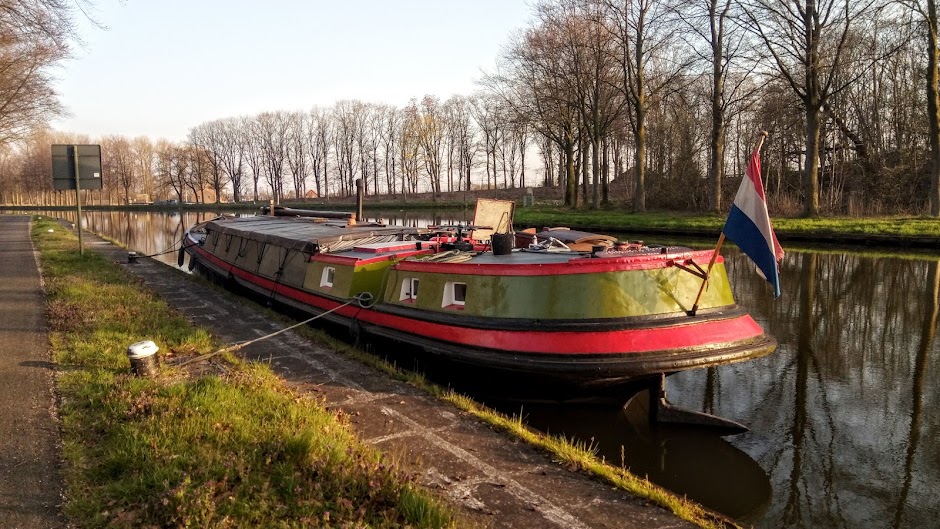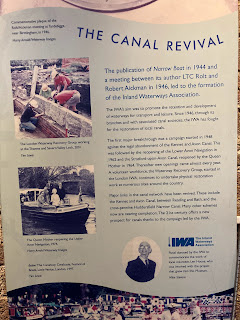Last week, I mentioned the London Canal Museum in my post but didn't write about it then because it is really worthy of its own post. So, without further ado, here it is.
Just to recap, we were doing a day trip to London courtesy of the Eurostar, something neither Koos nor I had ever done before, so it was something of an experiment. Given that we only had six hours between arriving in London and departing again for home, we didn't want to spend too much time travelling from one place to another. As a result, we confined our wanderings to the areas around St Pancras and King's Cross.
Having feasted our eyes on our usual suspects – the Regent's canal and all the boats thereon (see last post) – as well as the gasometers, we weren't quite sure what to do next.
"Look, the London Canal Museum is just a short walk from here." I pointed it out to Koos on Google maps. Its position was shown next to the harbour called Battlebridge Basin (also mentioned in my last post).
"Hmm," came the less than enthusiastic response. Koos, like me, doesn't really like museums, preferring to see history in the wild, so to speak. However, a canal museum appealed to me.
"Well, let's just walk to that harbour, anyway. We haven't been there before."
And so we set off, meandering through the back streets in what looked to be the general direction of the canal. I say 'looked to be' deliberately since I have zero sense of direction and it wasn't the same way we'd walked earlier in the day. What I'd forgotten was that in the morning, we'd crossed over the Regent's canal to the north side and turned west. This time, we were staying on the south side and turning a little east.
However, since I don't know my north from my south, let alone east from west, and imagining we were already on the other side of the Regent's Canal, I was taken by surprise when we walked up a side street and saw the entrance to the museum. Yes. I know. It sounds silly, doesn't it? Well, try living in my brain for a while and see how I feel.
Anyway, after some minor discussion about whether to go or not to go, I clinched the deal by saying to Koos, "Come on. I'll pay. At least it'll be warm in there!"
And what a treat it was.
The first item on display we noted after paying our dues was a beautifully restored towpath tractor. This one was built in 1960, and did the job horses were previously used for– towing barges along the canals.
As I also mentioned last week, this museum was on the site of two ice wells, the inspiration for which came from one Carol Gatti, a Swiss Italian immigrant who came to London to make his fortune in the 1850s and did so. He was a café owner, but he realised money could be made by supplying ice to all sorts of different businesses. His story, and that of the ice wells, is detailed on the Canal Museum's website, which you can find here. In short, though, he started importing ice from Norway not only to supply local business and hotels, but also to provide clean, natural ice for Italian ice cream makers. The imported ice was stored in these wells before being distributed. Previously, ice from local ponds and lakes had been used, but I dread to think how unhygienic that natural ice might have been...it doesn't really bear thinking of, does it?
Another aspect the museum focused on was about the children who both lived and worked on the canals. I was shocked to read that children were even employed to dig canals. In fact, I almost didn't believe it, but the photo below of the child navvies who helped dig the Manchester Ship Canal was somewhat chilling evidence of the truth.
But then children had to help the boatmen as well. The pictures below show a very young boy leading a a donkey along the towpath and a tiny girl tied to the roof of the narrowboat to prevent her from falling off.
We must have spent well over an hour reading these posters, after which we stepped through the back door into the serene haven of Battlebridge Basin. It was hard to imagine such a peaceful place could exist in the heart of London's inner suburbs, but a resident we spoke to told us it really was as blissful as it looked.
"I used to gaze at this place from the café in that building on the other side," she told us, gesturing across the harbour. "I used to stop for a coffee on my way home from child care with my daughter, and I was determined that one day I'd live here."
Well, now she does. She said she'd had to wait a year to find the right boat to buy in the harbour, but when it came up, there was no stopping her. Was she happy with her decision? The smile on her cheerful face said it all. I've borrowed the photo below from a website titled Battlebridge Moorings, which gives some background to the basin. It's lovely to think these boats will still have the right to moor here for generations to come. Have a read and see its history for yourself.
 |
| Photo thanks to battlebridgemoorings.co.uk. The museum is on the right-hand side of the photo. |
Well, that's it again allemaal. I hope you enjoyed browsing through the museum with me and learnt as much as I did. Next week, I'll catch up with more local doings. Enjoy the rest of this one, wherever you are.










Fascinating, as ever! Thanks for this canal history lesson, Val. Shirley
ReplyDeleteI'm so pleased you enjoyed it.
DeleteOh, Val! Thank you! Absolutely fascinating! The ice wells, the hardships of - especially children - living and working on the canal...and I laughed with you on your sense of direction - because that we share! As always...marvelous. (Steph)
ReplyDeleteAw, Steph, I'm so pleased you enjoyed reading this. Yes...you and I would not get anywhere fast, would we? Turn us both around once and we'd be totally lost. :))
DeleteAnother interesting post and I've enjoyed reading the about the history of the London Canal and its Canal folk. I have a great interest in canals, you'll remember my project documenting the Louth Canal in Licilnshire?
ReplyDeleteI've often wondered what it might be like to live on a Canal narrow boat or houseboat. Maybe not always as pleasant as it sounds
I'm sat with Popcorn enjoying your post with a cup of tea while the wind and rain continues outside. We've just had a spell of frosty days and snow, I'm assuming your weather has been similar to ours. Best wishes to you, Koos & of course Zoe. David.
David, once you're inside your boat, it's lovely and warm. We've just spent some time on Vereeniging and it was warmer there than in our little house. Small spaces heat up faster and there's nothing better than being on your own island...but then I'm biased, I know. Thank you for the good wishes. All the very very best to you too!
DeleteThis is a fascinating post, Val. The Canal Museum was a great choice. I loved the towpath tractors and the history of the ice wells.I believe that children often had jobs in the working class to help the family stay afloat. So much new info for me. Thanks!
ReplyDeleteThank you so much for your kind comment, Lynn. Oddly, I was convinced I’d already replied here, but either my brain or my tablet wasn’t working properly. 😄
DeleteI’m so pleased you found it informative. You’re right about the reasons for the children to work, and on the canals it was mostly within the family, but even so, many of them were very young.
What a fascinating blog, Val, thank you. Much as I loved that tractor with all his insides on display(!), I think I'd have preferred to see the horses. I wonder whether those children felt fortunate? Child labour being normal at that time, I suspect it was better 'working the boats' than down the mines or in sweaty factories. What a lovely story to end with. I'm so pleased for that lady! xx
ReplyDeleteBeth, I so agree with you on all counts. It was the child navvies that shook me, though. Mind you, it was probably better than the alternatives, as you say!
DeleteWhat a great blog Val, the Canal Museum was a hidden gem! I never realised that child labour was used to dig canals. I expect their families would have been glad of the money at that time. What a spot of luck meeting that lady who is now living her dream on Battlebridge Moorings. Rebecca x
ReplyDeleteThank you, Rebecca. Yes, I'm sure you're right about the money the children brought in. Times have changed, haven't they? That lady was definitely beaming with happiness.
Delete